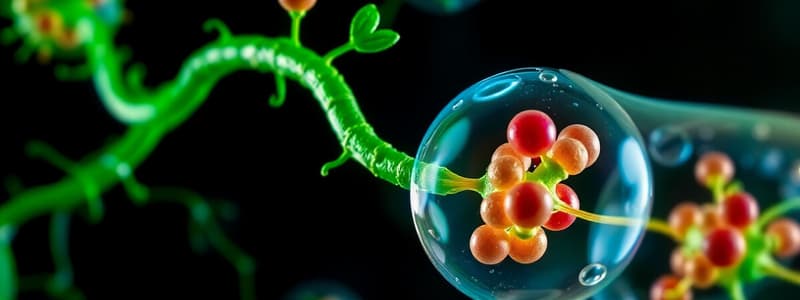Podcast
Questions and Answers
Is the reaction ADP + Pi → ATP an endergonic reaction?
Is the reaction ADP + Pi → ATP an endergonic reaction?
- False
- True (correct)
How many pyruvate molecules are produced from each glucose molecule during glycolysis, and where does the pyruvate then move?
How many pyruvate molecules are produced from each glucose molecule during glycolysis, and where does the pyruvate then move?
- 1 pyruvate molecule; nucleus
- 3 pyruvate molecules; Golgi apparatus
- 4 pyruvate molecules; endoplasmic reticulum
- 2 pyruvate molecules; mitochondria (correct)
Which of the following correctly lists three electron carrier molecules involved in cellular respiration and photosynthesis?
Which of the following correctly lists three electron carrier molecules involved in cellular respiration and photosynthesis?
- H2O, O2, C6H12O6
- ADP, Pi, G3P
- NADH, FADH2, NADPH (correct)
- ATP, RuBP, CO2
During cellular respiration, what happens to glucose as it becomes CO2?
During cellular respiration, what happens to glucose as it becomes CO2?
Why is glycolysis described as having an investment phase and a payoff phase?
Why is glycolysis described as having an investment phase and a payoff phase?
Which molecule(s) deliver(s) electrons to the Electron Transport Chain during cellular respiration?
Which molecule(s) deliver(s) electrons to the Electron Transport Chain during cellular respiration?
What are the major products of the citric acid cycle (Krebs cycle)?
What are the major products of the citric acid cycle (Krebs cycle)?
Is it true that ATP synthase makes a majority of the ATP during cellular respiration
Is it true that ATP synthase makes a majority of the ATP during cellular respiration
What are the two primary differences between aerobic and anaerobic cellular respiration?
What are the two primary differences between aerobic and anaerobic cellular respiration?
Which of the following can be broken down and used for cellular respiration?
Which of the following can be broken down and used for cellular respiration?
During fermentation, what accumulates in muscle cells when they run out of oxygen?
During fermentation, what accumulates in muscle cells when they run out of oxygen?
How is ATP synthase powered?
How is ATP synthase powered?
In what locations do photosynthesis and cellular respiration occur in plant cells?
In what locations do photosynthesis and cellular respiration occur in plant cells?
Is it true or false that plants also have mitochondria and therefore can do cellular respiration too
Is it true or false that plants also have mitochondria and therefore can do cellular respiration too
Plants use green light most effectively.
Plants use green light most effectively.
Which of the following processes occurs in the thylakoids of chloroplasts?
Which of the following processes occurs in the thylakoids of chloroplasts?
Photosystems, embedded in the thylakoid membrane, contain which special type of molecule?
Photosystems, embedded in the thylakoid membrane, contain which special type of molecule?
Why and where is water split during the light reaction of photosynthesis?
Why and where is water split during the light reaction of photosynthesis?
How are the light reactions and the Calvin cycle connected in photosynthesis?
How are the light reactions and the Calvin cycle connected in photosynthesis?
Pumping of H+ ions into the thylakoid by the ETC is a direct result of what?
Pumping of H+ ions into the thylakoid by the ETC is a direct result of what?
Flashcards
ADP + Pi → ATP Endorgonic?
ADP + Pi → ATP Endorgonic?
False. ADP + Pi → ATP is an endergonic reaction.
Pyruvate from Glucose
Pyruvate from Glucose
Two pyruvate molecules are made from one glucose molecule in the cytosol and moved to the mitochondria.
Electron Carrier Molecules
Electron Carrier Molecules
NADH, FADH2, and NADPH are electron carrier molecules used in cellular respiration and photosynthesis.
Cellular Respiration vs. Photosynthesis Equations
Cellular Respiration vs. Photosynthesis Equations
Signup and view all the flashcards
Glucose Oxidation
Glucose Oxidation
Signup and view all the flashcards
Glycolysis Phases
Glycolysis Phases
Signup and view all the flashcards
Electron Delivery to ETC
Electron Delivery to ETC
Signup and view all the flashcards
Citric Acid Cycle Products
Citric Acid Cycle Products
Signup and view all the flashcards
ATP Synthase and ATP
ATP Synthase and ATP
Signup and view all the flashcards
Aerobic vs. Anaerobic Respiration
Aerobic vs. Anaerobic Respiration
Signup and view all the flashcards
Cellular Respiration Fuels
Cellular Respiration Fuels
Signup and view all the flashcards
Fermentation in Muscles
Fermentation in Muscles
Signup and view all the flashcards
ATP Synthase Power Source
ATP Synthase Power Source
Signup and view all the flashcards
Location of Photosynthesis vs Cellular Respiration
Location of Photosynthesis vs Cellular Respiration
Signup and view all the flashcards
Plants and Cellular Respiration
Plants and Cellular Respiration
Signup and view all the flashcards
Plants and Green Light
Plants and Green Light
Signup and view all the flashcards
Thylakoid Events
Thylakoid Events
Signup and view all the flashcards
Photosystem Composition
Photosystem Composition
Signup and view all the flashcards
Water Splitting in Photosynthesis
Water Splitting in Photosynthesis
Signup and view all the flashcards
Link between Light Reaction and Calvin Cycle
Link between Light Reaction and Calvin Cycle
Signup and view all the flashcards
Study Notes
-
ADP + Pi → ATP is an endergonic reaction: True
-
Two pyruvate molecules are produced from each glucose molecule.
-
Pyruvate is transported from the cytosol to the mitochondria.
-
The three electron carrier molecules are NADH, FADH2, and NADPH.
-
Equation for photosynthesis: 6CO2 + 6H2O → C6H12O6 + 6O2
-
Equation for cellular respiration: C6H12O6 + 6O2 → 6CO2 + 6H2O + ATP
-
During cellular respiration, glucose is oxidized and loses electrons to become CO2.
-
Glycolysis has an investment phase and a payoff phase because it takes energy to start the reaction, but ultimately results in a net gain of 2 ATP molecules.
-
FADH2 and NADH deliver electrons to the electron transport chain (ETC) during cellular respiration.
-
The major products of the citric acid cycle (Krebs cycle) are 2 ATP molecules, CO2 from breaking down citrate, and banked electrons in the form of NADH and FADH2.
-
ATP synthase makes a majority of the ATP during cellular respiration: True
-
Two main differences between aerobic and anaerobic cellular respiration: anaerobic produces less ATP, and oxygen is not the final electron acceptor.
-
Steak, mashed potatoes, and butter can all be broken down and used for cellular respiration.
-
When muscle cells run out of oxygen, they perform fermentation, which can cause a buildup of lactic acid.
-
ATP synthase is powered by the passive flow of H+ ions.
-
Photosynthesis occurs in the chloroplast.
-
Cellular respiration occurs in the cytosol and the mitochondria.
-
Plants have mitochondria and can therefore perform cellular respiration: True
-
Plants do not use green light efficiently: False
-
Water splitting, ATP production, and the Calvin Cycle occur in the thylakoids of chloroplasts.
-
Photosystems are proteins embedded in the thylakoid membrane and contain chlorophyll.
-
Water is split by photosystem II to replace its lost electrons during the light reactions of photosynthesis.
-
Light reactions provide ATP and NADPH to the Calvin cycle, and the Calvin cycle returns ADP, Pi, and NADP+ to the light reactions.
-
Pumping of H+ ions into the thylakoid by the ETC is a direct result of energy donated by electrons excited by Sun energy.
-
During the Calvin cycle, NADPH is oxidized to donate electrons to form G3P: True
-
Plants reduce CO2 in the atmosphere to utilize in photosynthesis, which is essential for addressing global warming.
-
High concentrations of ATP inhibit enzymes at the beginning of cellular respiration, like glycolysis.
-
This feedback inhibition prevents the process from wasting energy when ATP is not needed.
-
C4 plants spatially separate the Calvin Cycle.
-
CAM plants temporally separate CO2 intake.
-
During fermentation, glucose is converted to pyruvate, netting 2 ATP.
-
The reaction doesn’t stop there because the cell needs to regenerate NAD+.
-
Cellular respiration is an exergonic reaction.
-
2 ATPs are made during glycolysis.
-
2 ATPs are made during the Krebs Cycle.
-
30+ ATPs are made during the ETC/ATP Synthase stage.
-
During aerobic cellular respiration, oxygen is the final electron acceptor and accepts electrons to become water.
-
If ATP synthase is inhibited, the Calvin Cycle would have no energy to use, which impacts photosynthesis.
-
The molecule produced by the Calvin Cycle that is used to make glucose: G3P
Studying That Suits You
Use AI to generate personalized quizzes and flashcards to suit your learning preferences.




